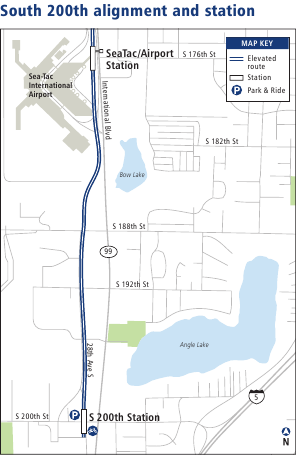Sound Transit’s board of directors have selected a contractor to expand Link light rail south from Seattle-Tacoma International Airport to the intersection of South 200th St and 28th Avenue South, the agency announced today.
PCL Civil Constructors, Inc. has been awarded a contract to bring Link’s southern terminus into the southern part of SeaTac, with service to begin just four years from now, in September of 2016. PCL’s bid came in at $169 million, which is less than the $170 to $190 million cost Sound Transit had projected.
Over the next four years, PCL will design and build the guideway for the 1.6 mile extension (which I’m going to call Angle Lake Link for the sake of brevity and clarity) as well as the station, which does not yet have a final name. (It will be either South SeaTac, S. 200th Street, or Angle Lake; I personally prefer Angle Lake).
“After reviewing technical and cost proposals from four previously-qualified proposers, Sound Transit identified PCL as the highest ranking firm with demonstrated expertise in design-build methods,” said Ahmad Fazel, Executive Director of Design, Engineering, and Construction Management in a news release.

“The important work PCL and Sound Transit will accomplish together will enable the agency to deliver the South 200th Link Extension project on an accelerated schedule.”
The words accelerated schedule are an understatement, if you ask me. What Sound Transit has accomplished over the last year is really significant. They’ve moved up the completion date for this component of Link’s expansion from 2020 to 2016. For real. That’s huge. It means that in 2016, Link will be expanding in two directions simultaneously — north (to the University of Washington) and south (to Angle Lake in SeaTac) — adding a total of three new stations.
Plans for the Angle Lake station call for a parking garage with seven hundred stalls, though that will be built separately under a different contract than the agreement approved today. Sound Transit is also looking at adding several hundred additional parking spaces to accommodate people who want to park and ride.
Here’s an overview of what people can expect from the new station:
The elevated station will include passenger platforms with covered waiting areas, a transfer area for local and rapid ride bus connections, dedicated areas for passenger pickup and drop off, and vanpool parking. Secured bicycle storage, street improvements to accommodate traffic circulation, bicycle and pedestrian access, landscaping and public art are also elements of the project.
Sounds good. It sounds like the Tukwila International Boulevard Station, actually, which was the southern terminus of Link for the six months in between opening weekend and the completion of the airport extension.
Angle Lake Link will also bring light rail one step closer to Federal Way, whose leaders have been upset with Sound Transit ever since the agency disclosed that the South King subarea just isn’t generating enough revenue for the agency to expand Link to Federal Way by 2023 as originally planned. Link could still get to Federal Way within the next fifteen years if money is found, but at the moment, Sound Transit only has funds for planning work.
Redmond, NPI’s hometown, is in the same boat. Sound Transit is committed to getting East Link to Overlake, but light rail won’t reach downtown Redmond until more money is found. The city has incorporated the arrival of light rail into its transportation planning so construction doesn’t have to be needlessly delayed once money is available. Redmond is doing its best to be patient; Federal Way’s elected officials would be wise to follow Redmond’s example.
We encourage Sound Transit to keep hunting for dollars to get light rail to more communities. Each new extension boosts ridership and makes the system accessible to more people. Our region badly needs more light rail and streetcars to give people transportation choices so they’re not forced to drive to get around.

Historical footnotes for the record:
The South 200th St Station was part of the original Sound Move electric light rail plan of 1996, estimated back then to be completely funded with the original tax levels approved that year. Light rail was originally set to be completed by 2006 from S 200th to the U District. A copy of the Sound Move documentation from 1996 with five mentions of S 200th is at http://www.bettertransport.info/pitf/SoundTransit1996SoundMovePlan.pdf.
Given the original 2006 completion date, calling the now scheduled 2016 completion of S 200th a case of “acceleration” is putting lipstick on a pig of a project.
By “pig” I’m referring to the way Sound Transit slurped at the competitive transit funding trough for several recent years even after getting a second tranche of tax funding in the Mass Transit Now victory of 2008.
My 2009 comments to PSRC on Sound Transit’s piggy behavior at the expense of other transit agencies is at http://www.bettertransport.info/pitf/NilesPSRC-TIPcomment.pdf.
Not surprisingly in the 15 year development process for the S 200th extension a bit of money was wasted along the way. At a point about a decade ago Sound Transit had a very grand (expensive) station design for S 200th that was quietly shelved and written off. It matched the grandeur of the present Tukwila Station. There’s a model of the first S 200th Station design pictured at http://tinyurl.com/3admvab.
But as a related case of non-restraint, it’s quite remarkable that our region will in 2016 have both light rail and bus rapid transit (Metro RapidRide A) running next to each other in the vicinity of the Airport.